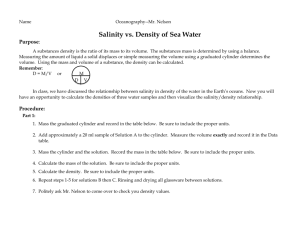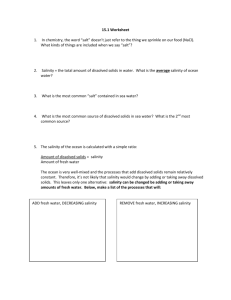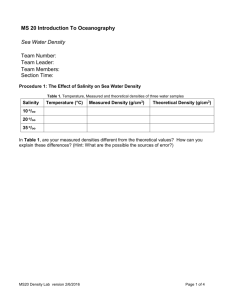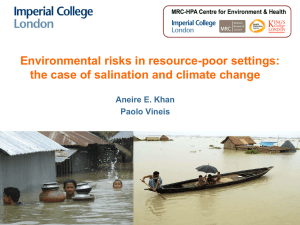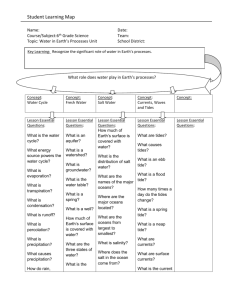Carbon Dioxide Mop - da Vinci Decathlon
advertisement
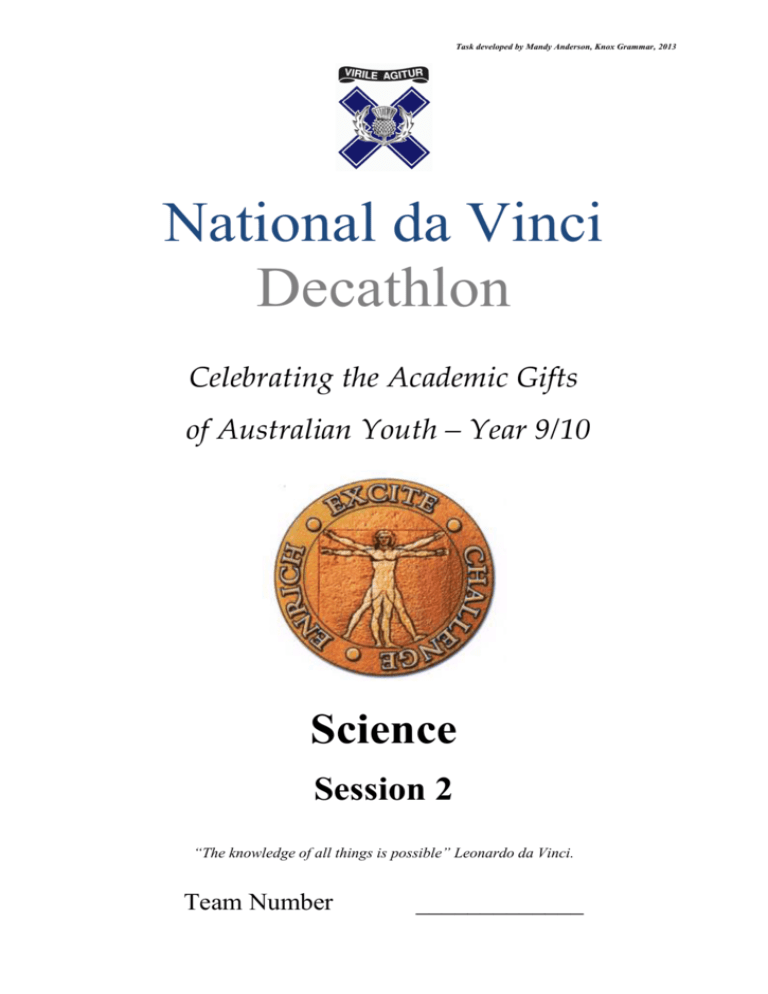
Task developed by Mandy Anderson, Knox Grammar, 2013 National da Vinci Decathlon Celebrating the Academic Gifts of Australian Youth – Year 9/10 Science Session 2 “The knowledge of all things is possible” Leonardo da Vinci. Team Number _____________ Task developed by Mandy Anderson, Knox Grammar, 2013 The Murray-Darling River Basin: Differing Perspectives on Water Use The Murray-Darling River Basin (MDRB) covers over one million square kilometres of eastern Australia. More than 2 million people live in the basin, with an additional 1.3 million relying on its water resources, including the city of Adelaide. The MDRB is Australia’s most important agricultural area, generating 39% of Australia’s agriculture income. In addition, the MDRB harbours many key ecosystems such as wetlands, blue gum forest, floodplains, and estuaries. Over the past 100 years, so much water has been removed from the rivers of the MDRB that the health of this vast river system is 1http://commons.wikimedia.org/wiki/File:Murraythreatened, putting at risk all the ecosystems and industry catchment-map_MJC02.png dependent upon it. Therefore the Federal Government enacted a water management plan which came into effect on October 20, 2012. When the Murray-Darling Basin Management Plan was released there was a great deal of public debate, with many different groups bringing different perspectives to the table. 1. With reference to the cartoon, identify the different voices in the Murray-Darling Water debate. For each of the groups, state their main priority in the management of the MDRB. (6 marks) 2http://politicalcartoonsaustralia.com/tag/burke/ ___________________________________________________________________________ ___________________________________________________________________________ ___________________________________________________________________________ ___________________________________________________________________________ ___________________________________________________________________________ ___________________________________________________________________________ 2 Task developed by Mandy Anderson, Knox Grammar, 2013 Soil Salinity Much of the basin has been heavily impacted by high salt concentrations in the soil. These salts have accumulated through 2 processes – dryland salinity and irrigation salinity. 2. Use the diagrams below to describe the processes by which soil becomes saline. (4 marks) Dryland Salinity 3http://vro.dpi.vic.gov.au/dpi/vro/vrosite.nsf/pages/lwm_salinity_management_dryland Irrigation Salinity 4http://vro.dpi.vic.gov.au/dpi/vro/vrosite.nsf/pages/lwm_salinity_management_irrigation ___________________________________________________________________________ ___________________________________________________________________________ ___________________________________________________________________________ ___________________________________________________________________________ ___________________________________________________________________________ ___________________________________________________________________________ ___________________________________________________________________________ __________________________________________________________________________ 3 Task developed by Mandy Anderson, Knox Grammar, 2013 Water Quality The quality of the water throughout the river system is affected by the soil salinity. The salt leaches from the soil into the rivers and passes throughout the system downstream. It is important that the salinity levels in the river are carefully monitored to determine whether the water is suitable for use in agriculture, as drinking water, and to gauge the ongoing health of riparian ecosystems. Qualitative test: The presence of salt can be determined qualitatively by adding silver nitrate to the water sample. If salt is present, a white precipitate of silver chloride will be formed. 3. What is the chemical name of the most common salt found in the environment? (1 mark) __________________________________________________________________________ 4. Write a balanced chemical equation for this qualitative test. (3 marks) ___________________________________________________________________________ Quantitative test: A quantitative version of this same test can be conducted by adding silver nitrate to a known mass of water and weighing the precipitate which is formed. 5. An excess of silver nitrate was added to a 5kg sample of river water. 0.235g of precipitate was formed. Calculate the salt concentration of the water sample. Note: the mass of one mole of silver chloride is 143.5g The mass of one mole of sodium chloride is 58.44g (4 marks) _____________________________________________________________________ _____________________________________________________________________ _____________________________________________________________________ _____________________________________________________________________ _____________________________________________________________________ _____________________________________________________________________ _____________________________________________________________________ _____________________________________________________________________ 4 Task developed by Mandy Anderson, Knox Grammar, 2013 6. Taking water from the river system and using it for irrigation has greatly increased soil salinity in the MDRB. Analyse the arguments for and against reducing irrigation in the MRDB. (8 mark) ___________________________________________________________________________ ___________________________________________________________________________ ___________________________________________________________________________ ___________________________________________________________________________ ___________________________________________________________________________ ___________________________________________________________________________ ___________________________________________________________________________ ___________________________________________________________________________ ___________________________________________________________________________ ___________________________________________________________________________ ___________________________________________________________________________ ___________________________________________________________________________ ___________________________________________________________________________ ___________________________________________________________________________ ___________________________________________________________________________ 5 Task developed by Mandy Anderson, Knox Grammar, 2013 Salinity and Ecosystems The yabby is sensitive to environmental conditions. It is an indicator species in the MDRB. Environmental scientists use the health of the yabby population as another means of determining levels of water pollution, including salinity. 5 http://www.flickr.com/photos/christop/2440409492/in/photo stream/ 7. Describe how scientists can use indicator species such as the yabby to monitor water quality. (3 marks) ___________________________________________________________________________ ___________________________________________________________________________ ___________________________________________________________________________ ___________________________________________________________________________ ___________________________________________________________________________ ___________________________________________________________________________ 8. Use the following description to draw a food web for the organisms in a waterhole of the MDRB. (3 marks) Algae is eaten by both snails and shrimp which are both consumed by the yellowbelly fish. The shrimp is also eaten by the gudgeon which in turn is eaten by the yellowbelly. Yabbies eat gudgeon and are consumed by the yellowbelly. Plankton is eaten by smelt. 6 Task developed by Mandy Anderson, Knox Grammar, 2013 9. Describe the effect upon the snail population if most of the yabbies die out due to poor water quality. Justify your answer. (2 marks) ___________________________________________________________________________ ___________________________________________________________________________ ___________________________________________________________________________ ___________________________________________________________________________ 10. The Murray cod is a large carnivorous fish which has almost disappeared from the MDRB due to overfishing and habitat destruction. However, environmental scientists are beginning to reintroduce the Murray cod into the river system. Describe how this reintroduction would impact the other species in the waterhole food web drawn above. (4 marks) __________________________________________________________________________ ___________________________________________________________________________ ___________________________________________________________________________ ___________________________________________________________________________ ___________________________________________________________________________ ___________________________________________________________________________ END OF TASK 7




